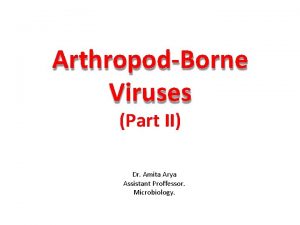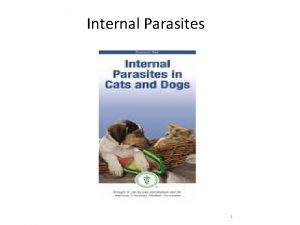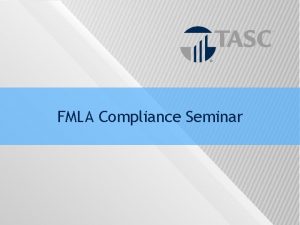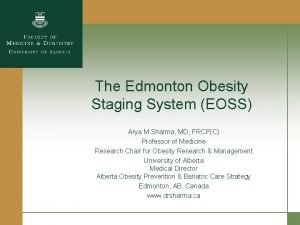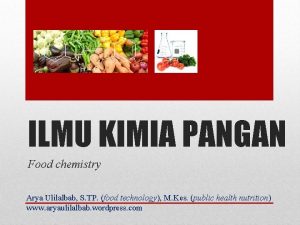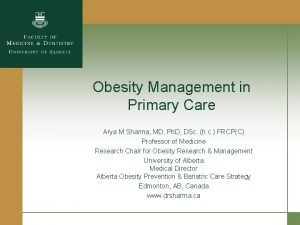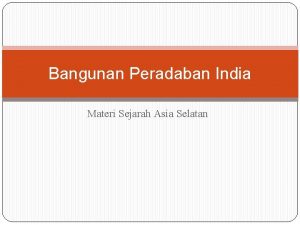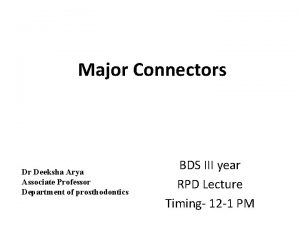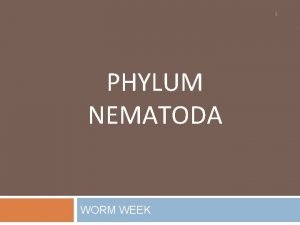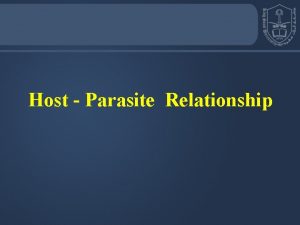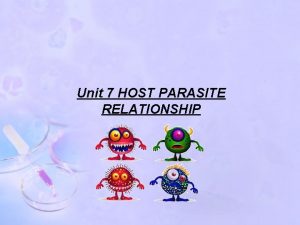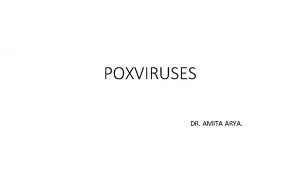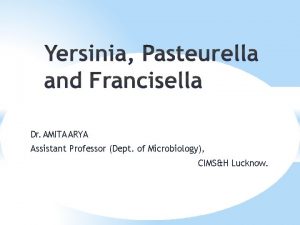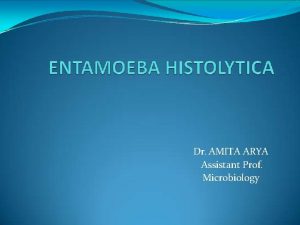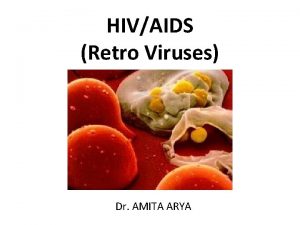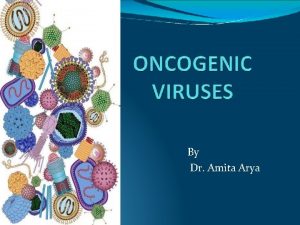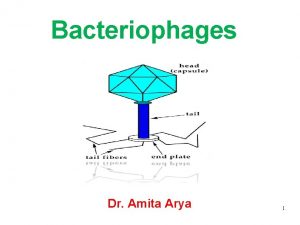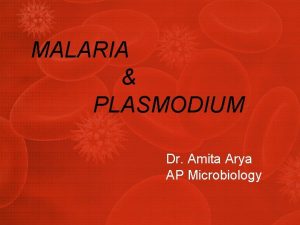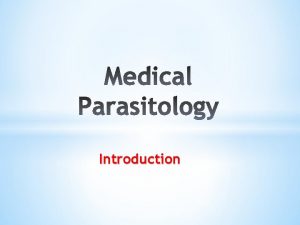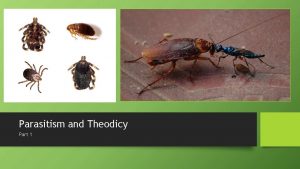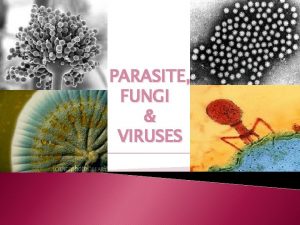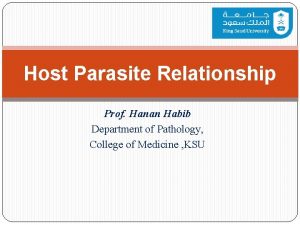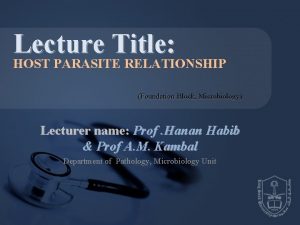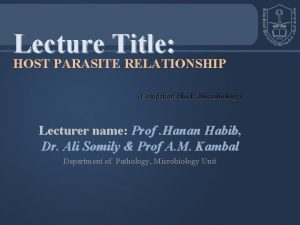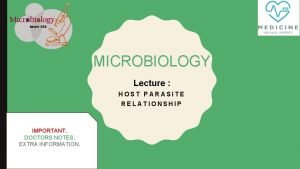HOST PARASITE RELATIONSHIP Dr Amita Arya CONTENTS HOST




















- Slides: 20

HOST PARASITE RELATIONSHIP Dr. Amita Arya.

CONTENTS HOST PARASITE RELATIONSHIP • Introduction • Symbiosis • Types of symbiosis SOME IMPORTANT TERMS • Host • Parasite • Pathogen • Types of pathogen • Pathogenicity • Resservoir • Virulance

Host Parasite Relationship Introduction the relationship between two organism can be very complex. The normal flora present in its normal site in human body provides some benefits to the host they live in the perfect symbiosis in their natural habitate. The host parasite relationship is two types – 1) Beneficial 2) harmful

Simbiosis is define as “life togather”. i. e. that two organisms live in an association with one another.

Types of Simbiosis • Commensalism- parasite Driving nourishment to the host without causing any harm or benefit to the host. • Parasitism- the relationship may be in which one organism damage the other. • Mutalism- Both members of association benefit.

Some important terms Host are the large animal and plant organism on or in which a parasite can live.

Parasite • lives on or within a host organism. • They cause disease in the host.

Pathogen is a microoganism is able to produce disease. Pathogenicity It is the ability of a microorganism to cause disease in another organism.

Resservoir • Any person, plant, soil and substance in which an infectious agent normally lives and multiplies.

Virulance • Degree of pathogenicity of microorganism agent to cause disease. • It involves adherence, invasion and toxigenicity.

Adherence • The process by which bacteria stick to the surface of host cell. a) Ffimbriae / pili (hair like structure) of bacteria. b) Capsule (sticky polysaccharide material) of bacteria. c) Capsid spikes of viruses.

Invasion process by which bacteria, parasite enter into the host cell and spread in the body. There are many barriers present on host by the breaking of these barriers the parasite enters into the host cell. Eg. - skin / mucous membrane.

Toxigenecity The ability of microorganism to produce toxins.

Normal flora • The body of a healthy individual is inhabited by many different microorganism. • Normal flora is acquired after birth from food and environment. • They occupy site. • i. e. Skin, Mouth, Respiratory tract, Intestinal tract and genitourinary tract.

Entry of microorganism into the host • There are several sites for the entry of Microorganism. 1) 2) 3) 4) 5) 6) 7) Skin / Mucous membrane Nose Eyes Mouth cavity Respiratory tract Intestinal tract Genitourinary tract

PARASITISM: Parasitism is type of symbiotic relationship, or long-term relationship between two species, where one member, the parasite, gain benefits that come at the expense of the host member. The word parasite comes from the Latin form of the Greek word (parasitos), “meaning one eats at the table of another”. �TYPES OF PARASITES. � 1. Ectoparasites � 2. Endoparasites

ECTOPARASITISM and ENDOPARASITISM: Ectoparasites are parasites that live on the outside of the host’s body, such as lice and ticks. Endoparasites are parasites that present inside the host’s body, such as nematodes and hookworms.

EXAMPLE OF PARASITISM;

ENTRY OF PATHOGEN INTO HOST: Most pathogens must gain access to the host tissues, penetrate or evade host defenses and damages the host tissue. Pathogens can enter to human body or other host through several avenues called portals of entry. PORTALS OF ENTRY: MUCOUS MEMBRANES (moist mucosa) SKIN (karatinized cutaneous membrane), PARENTERAL ROUTE:

Thank you
 Amita arya
Amita arya A definitive host harbors which stage of a parasite
A definitive host harbors which stage of a parasite Parasite symbiotic relationship
Parasite symbiotic relationship Ismael gama
Ismael gama Amita dhanda
Amita dhanda Fmla form amita
Fmla form amita Amita prasad ias
Amita prasad ias Amita mehta nasa
Amita mehta nasa Definitive host vs intermediate host
Definitive host vs intermediate host Edmonton obesity staging system
Edmonton obesity staging system Arya kimia
Arya kimia Arya opera
Arya opera Arya overweight
Arya overweight Indo arya dan dravida
Indo arya dan dravida Half pear shaped lingual bar
Half pear shaped lingual bar @?????? ???:http://work4unity.in/haicantik.html
@?????? ???:http://work4unity.in/haicantik.html Youtube.com
Youtube.com Kitab suci agama budha adalah . . . *
Kitab suci agama budha adalah . . . * Arya south asia 46m series 14msinghtechcrunch
Arya south asia 46m series 14msinghtechcrunch @arya ia:http://work4unity.in/haicantik.html
@arya ia:http://work4unity.in/haicantik.html Ascaris
Ascaris
